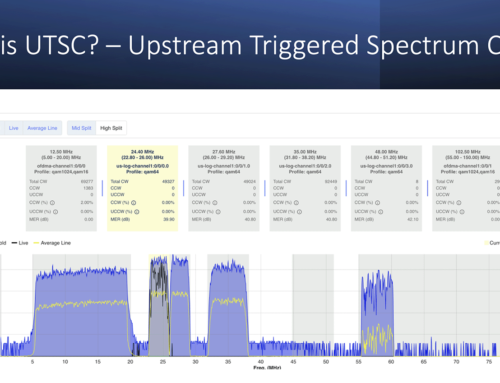Making a DOCSIS CMTS Upgrade? Make sure you have done your homework.
With all of the publicity focussed on DOCSIS on DOCSIS 3.1 many cable operators still have existing networks that are running DOCSIS 2.0 or even DOCSIS 1.1. Many conversations arise around what is the best path forward on making a smart DOCSIS CMTS upgrade. Should investments be made in addition DOCSIS CMTSs identical to equipment already installed? This is especially true when there is a lot of existing DOCSIS 1.1 and 2.0 equipment available at rock bottom prices on the used market. Next comes the more difficult questions of whether or not to upgrade to DOCSIS 3.0 or even worse, hold off for DOCSIS 3.1.
I address questions like these nearly on a weekly basis with clients. The answers are not one size fits all as every cable system is different. Size, demographics and past data usage all play a factor into it. According to the Cisco VNI 2013 Networking Solutions White Paper, we are on the precipice of some serious traffic increases:
The number of devices connected to IP networks will be nearly three times as high as the global population in 2017. There will be nearly three networked devices per capita in 2017, up from nearly two networked devices per capita in 2012. Accelerated in part by the increase in devices and the capabilities of those devices, IP traffic per capita will reach 16 gigabytes per capita in 2017, up from 6 gigabytes per capita in 2012.
Globally, 65 percent of all Internet video traffic will cross content delivery networks in 2017, up from 53 percent in 2012.
The take aways from this summary study can be summarized in the following two bullets:
- Mobile IP devices (iPads, iPhones, Android, etc.) will dramatically increase in quantity on our DOCSIS networks
- These mobile devices will pull (and push) significantly more IP data than traditional set top boxes resulting in substantially more load on DOCSIS CMTSs.
The end result means that as cable operators we should expect 50% or more increased utilization each year on our DOCSIS CMTSs.
How Do We Plan for This?
One of the challenges of operating a DOCSIS network is maintaining subscriber quality of experience (QoE) on our DOCSIS network in the presence of significant traffic growth. This is especially critical during peak usage hours between 6pm and midnight. The rule of thumb is to not let the CMTS utilization exceed 80%. First you need a monitoring system in place to ensure that your CMTS is not exceeding utilization thresholds and recording your historical utilization data.
As you are monitoring utilization history it is a best practice to perform capacity planning. Capacity planning is numerical modeling exercise that takes the past CMTS usage, analyzes your system’s demographics, your CMTS capabilities, then plots the future of when you will run out of data bandwidth. The objective of a properly performed capacity planning study is to provide accurate data and a proposed CMTS architecture that will size your new DOCSIS network to last at least five (5) years.
We recommend a goal of five years because the investment in CMTS equipment is significant along with the planning and time to install and re-cable a headend to install the equipment. This also takes into account the IP changes that often impact the subscriber, such as static ip changes which can impact business operations. A CMTS upgrade is not a tribal excursive and can be painful to the cable operator and the subscriber, especially if it is not properly executed.
Benefits of Smart Capacity Planning
Capacity planning can help make good decisions in CAPEX investments of a cable operators money. It can also help cable operators avoid costly mistakes by investing in CMTS equipment that will not meet their future demands.
A good example of this can be shown in the image below which is from a capacity planning study conducted last year. This shows a cable operator with a DOCSIS 3.0 CMTS that was limited to four (4) channel downstream bonding. The study showed that with the current CMTS the cable operator would run out of downstream capacity sometime in calendar year 2013 (the image shown is high-level and leaves out details for the purpose of this article).

Once this limitation of the CMTS was identified, it was clear that the current architecture would not support the operator for much longer. An intelligent decision based on factual information could then be made to migrate to a different CMTS platform. Further, the expected capacity needs had been calculated out to the 2018. Using this data a CMTS architecture was designed that would support this capacity with room for growth. In early 2013 the DOCSIS CMTS has much more capacity than what the network needs, however the scalability of the platform chosen is expected to not need new RF or IP re-configuration for several years to come.
Conclusion
Regardless of where you may be in your DOCSIS deployment, DOCSIS 1.1, 2.0, 3.0 or looking at the DOCSIS 3.1 horizon, it is recommended to take the time to plan at least five (5) years into the future. Using your existing data and rapidly changing industry CAGR numbers, the results of what your DOCSIS network will look like in just a few years can be startling. If you would like some help with this, feel free to contact us, we have proven modeling tools ready to help you.
Featured image courtesy of renjith krishnan at FreeDigitalPhotos.net
Previous events can be seen under the blog.
- If you are watching this on youtube please hit the subscribe button!
- Let us know what you think and remember to share!
- You can find slides at the bottom of the page and some on slideshare.
- Find out about events or articles by following us on Twitter, LinkedIn or Facebook too.
- We have stuff. Interested in buying some clothes with cable stuff. Click here
Also available on iTunes, Google Podcasts, Spotify, vurbl see podcasts “get your tech on”.





Leave a Reply